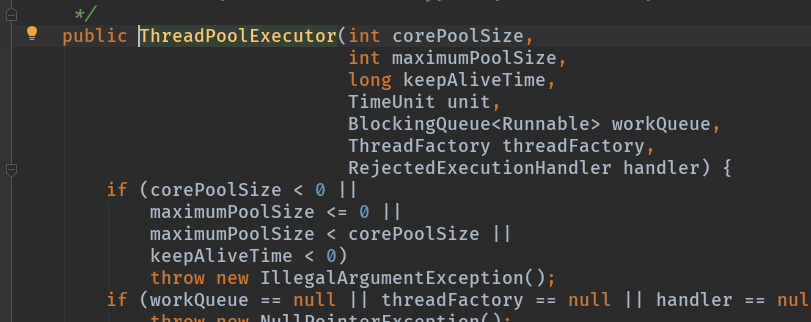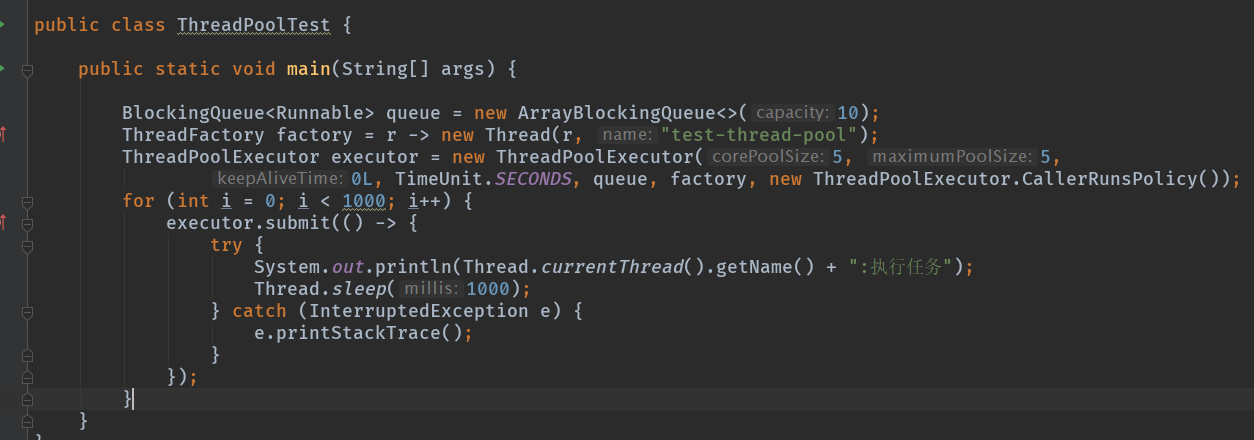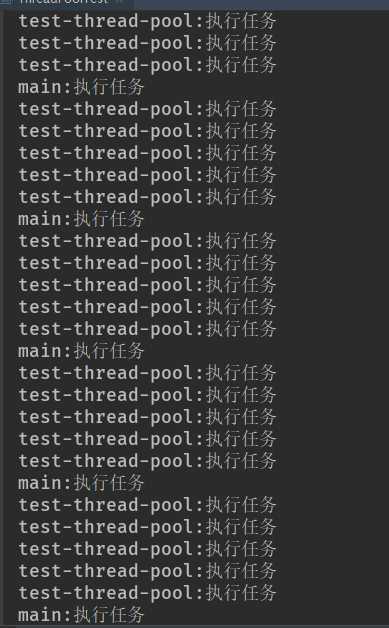前言
线程池,相信很多人都有用过,没用过相信的也有学习过。但是,线程池的拒绝策略,相信知道的人会少许多。
四种线程池拒绝策略
当线程池的任务缓存队列已满并且线程池中的线程数目达到maximumPoolSize时,如果还有任务到来就会采取任务拒绝策略,通常有以下四种策略:
1 | ThreadPoolExecutor.AbortPolicy:丢弃任务并抛出RejectedExecutionException异常。 |
线程池默认的拒绝策略
既然有四种拒绝策略可以选择,那么线程池的默认拒绝策略是什么呢?查看java.util.concurrent.ThreadPoolExecutor类的源码,我们可以看到:
1 | /** |
线程池的默认拒绝策略为AbortPolicy,即丢弃任务并抛出RejectedExecutionException异常。我们可以通过代码来验证这一点,现有如下代码:
1 | public class ThreadPoolTest { |
这里是一个默认的线程池,没有设置拒绝策略,设置了最大线程队列是100。运行代码:

结果是符合预期的,这也证明了线程池的默认拒绝策略是ThreadPoolExecutor.AbortPolicy:丢弃任务并抛出RejectedExecutionException异常。
设置线程池拒绝策略
如果我们想要根据实际业务场景需要,设置其他的线程池拒绝策略,可以通过ThreadPoolExecutor重载的构造方法进行设置:

现在的开发中,相信大家都有使用spring,其实我们也可以通过spring提供的org.springframework.scheduling.concurrent.ThreadPoolTaskExecutor构建线程池。如下:

1 |
|
通过ThreadPoolTaskExecutor的setRejectedExecutionHandler设置拒绝策略即可。
拒绝策略场景分析
AbortPolicy
ThreadPoolExecutor.AbortPolicy:丢弃任务并抛出RejectedExecutionException异常。
1 | A handler for rejected tasks that throws a {@code RejectedExecutionException}. |
这是线程池默认的拒绝策略,在任务不能再提交的时候,抛出异常,及时反馈程序运行状态。如果是比较关键的业务,推荐使用此拒绝策略,这样子在系统不能承载更大的并发量的时候,能够及时的通过异常发现。
DiscardPolicy
ThreadPoolExecutor.DiscardPolicy:丢弃任务,但是不抛出异常。如果线程队列已满,则后续提交的任务都会被丢弃,且是静默丢弃。
1 | A handler for rejected tasks that silently discards therejected task. |
使用此策略,可能会使我们无法发现系统的异常状态。建议是一些无关紧要的业务采用此策略。例如,本人的博客网站统计阅读量就是采用的这种拒绝策略。
DiscardOldestPolicy
ThreadPoolExecutor.DiscardOldestPolicy:丢弃队列最前面的任务,然后重新提交被拒绝的任务。
1 | A handler for rejected tasks that discards the oldest unhandled request and then retries {@code execute}, unless the executor is shut down, in which case the task is discarded. |
此拒绝策略,是一种喜新厌旧的拒绝策略。是否要采用此种拒绝策略,还得根据实际业务是否允许丢弃老任务来认真衡量。
CallerRunsPolicy
ThreadPoolExecutor.CallerRunsPolicy:由调用线程处理该任务
1 | A handler for rejected tasks that runs the rejected task directly in the calling thread of the {@code execute} method, unless the executor has been shut down, in which case the task is discarded. |
如果任务被拒绝了,则由调用线程(提交任务的线程)直接执行此任务,我们可以通过代码来验证这一点:
把之前的代码修改如下:
1 | public static void main(String[] args) { |

把队列最大值改为10,打印输出线程的名称。执行结果如下:

通过结果可以看到,主线程main也执行了任务,这正说明了此拒绝策略由调用线程(提交任务的线程)直接执行被丢弃的任务的。
总结
本文介绍和演示了四种线程池拒绝策略,具体使用哪种策略,还得根据实际业务场景才能做出抉择。